
Sup internet,
It’s that time of the year again: Mary Meeker, the “queen of the internet”👸🏼👾, has done her analysis 🕵🏼♀️ and her legendary Internet Trends Report is out for 2019! This time it come in at 333 pages and it’s once again jam-packed with hockey-stick charts. 🏒 Reminding us that the internet is going only north.🚀
A few weeks back, when Meeker announced the successful raise of her first $1.25bn Bond fund, I already mentioned her epic reports. She’s been putting out them slide decks since 1995, first at Morgan Stanley, then at Kleiner. At that time, I wasn’t sure whether she would still find the time and resources at her new fund to prepare the mammoth slide deck.
But she did not disappoint and presented her annual report at the Code Conference 2019 in Scottsdale Arizona yesterday:
She started her presentation off saying
this is a presentation that’s meant to be read not presented, so the critiques about the presentation style are justified
Like always, she rushed through the 333 pages slide deck like a Wall Street MD reviewing the work of a first year analyst, with little time to dive deeper into most topics.
In this little summary of mine, I provide a selective list of the must-read slides + some personal context.
So let’s dig in:
Internet users👩🏼💻👨🏻💻
The report always starts with this macro section. It’s typically the most bit dry of the report, but always good to remember where we actually stand in the evolution of the internet.
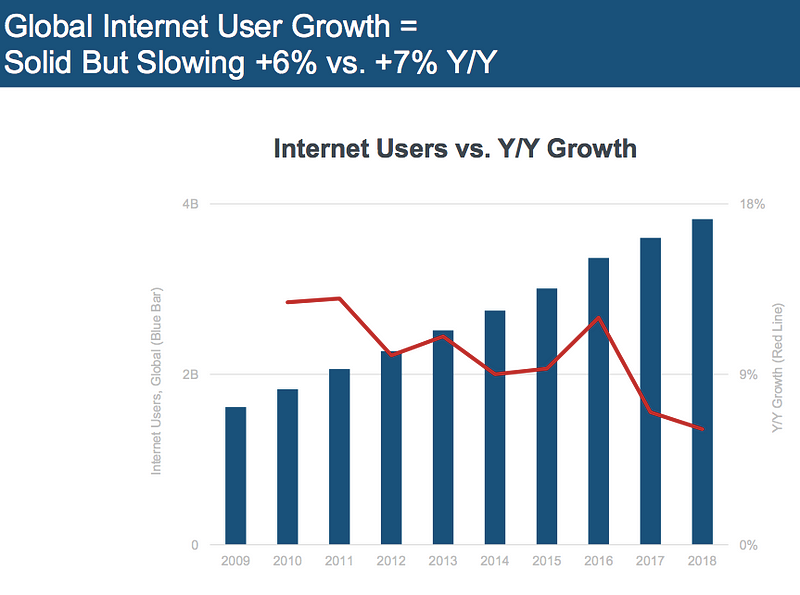
The internet is still growing overall, but growth is slowing down 🐆 →🐌 This is no surprise, given the high penetration level we’re at by now, >50%:
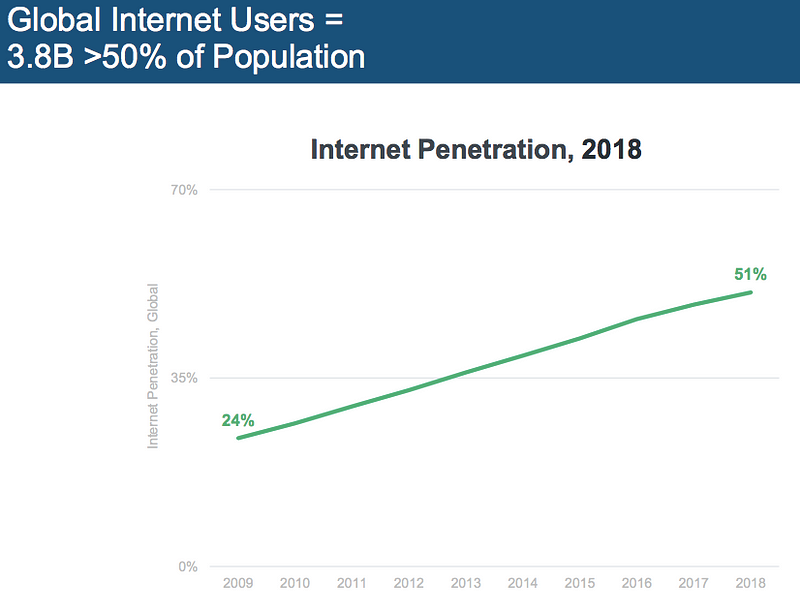
Can’t believe the internet was at just 24% penetration ten years ago? 😮 They grow up so fast.
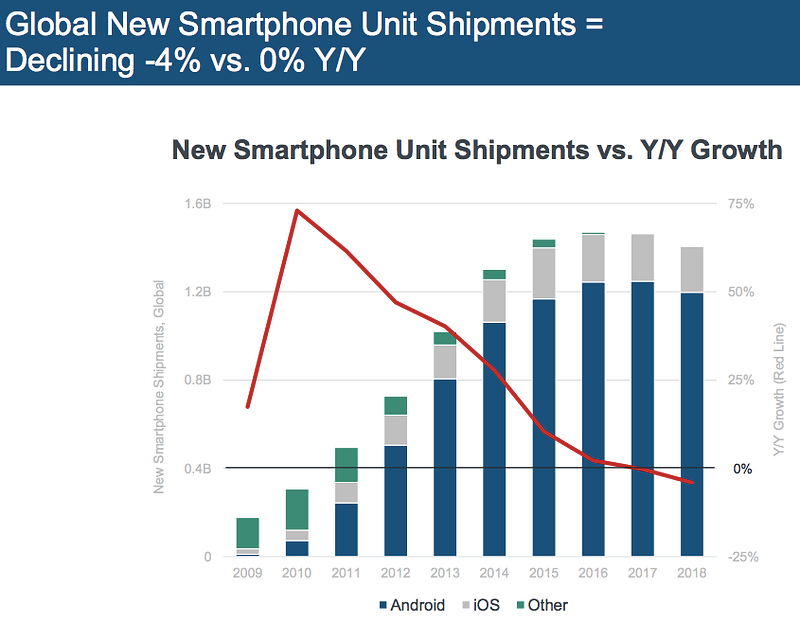
New smartphone shipments down: I personally have 3 smartphones in use, I don’t need another one! 🙅🏻♂️
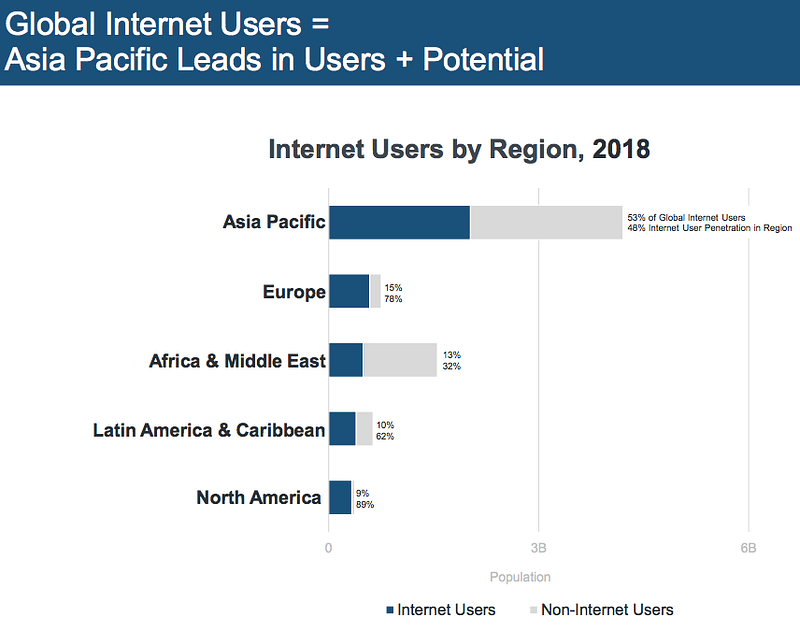
China is the largest market 🇨🇳🔥, both in terms of total active users and in terms of users who are still offline.
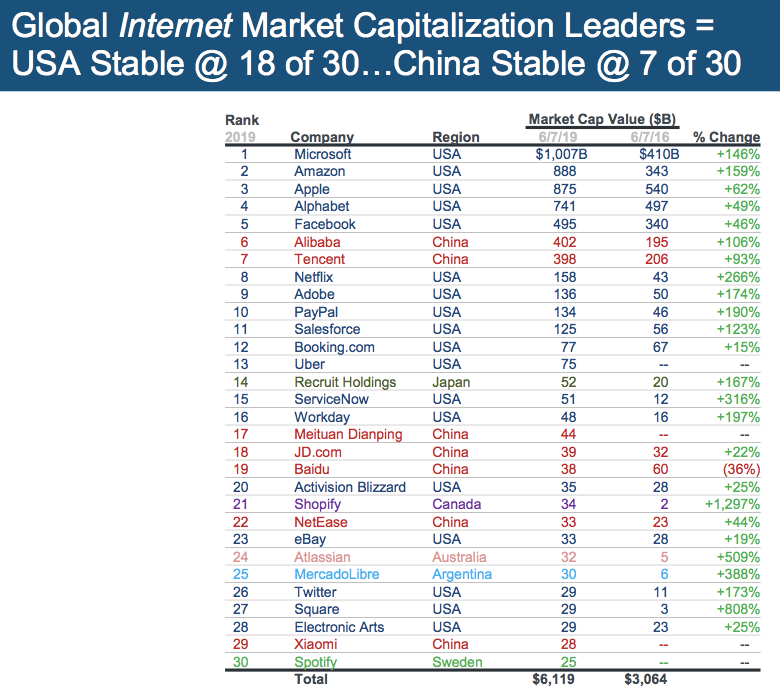
The internet market cap ‘hall of fame’ is still a lead by the tech giants from the US 🇺🇸. We all know that the internet is still a major US ‘export product’. This will only continue with the consolidation at the application layer, aka FAANG. But great to see a European decacorn 🦄 enter the list with Spotify. 🇸🇪🙌🏻
E-commerce 📦🛍
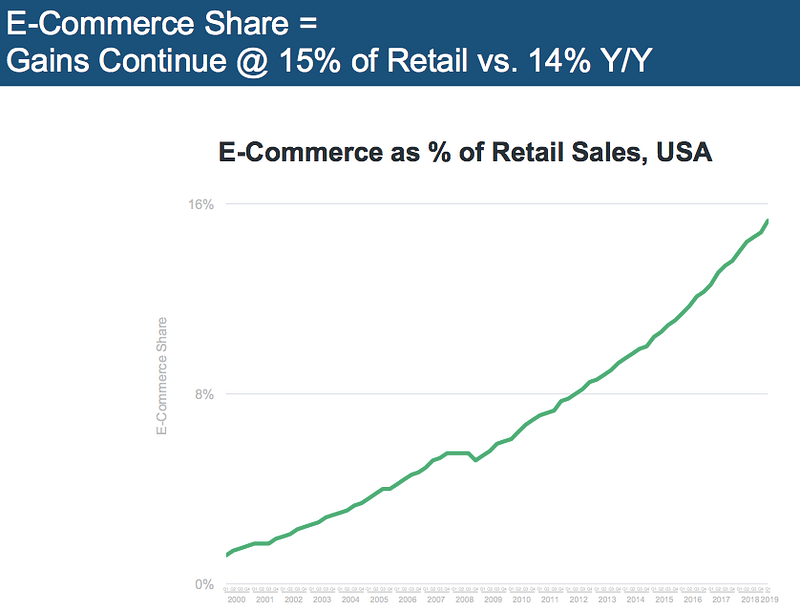
While everyone’s crying that bricks-and-mortar is dying ⚰️ , it’s always good to remember that we’re just in the first inning and that e-commerce is still only at 15% of total retail. And actually, brick-and-mortar retail is still growing. 👇🏻
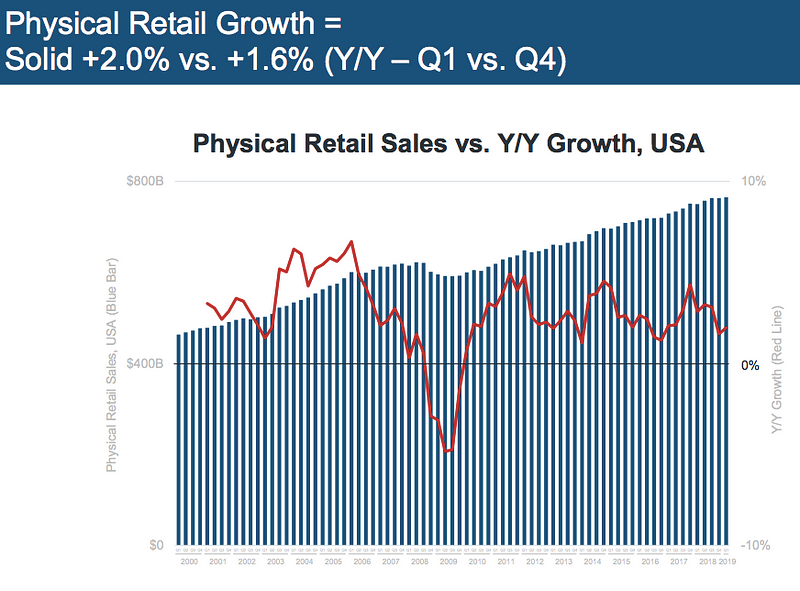
Just, that e-commerce is growing at 6x the rate of physical retail at 12% (down a few basis points from last year). 🚀
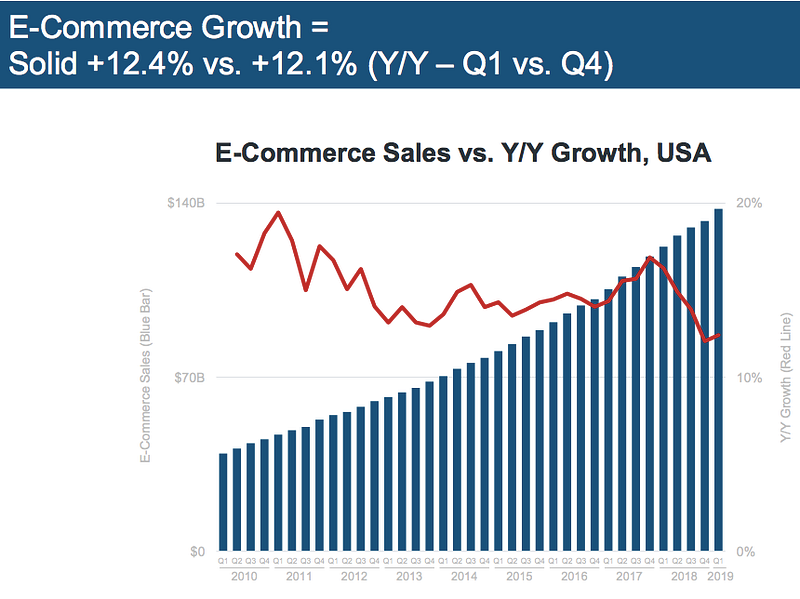
Online advertising 👀📣
I love this chart that’s been a fixture in the Meeker report. Basically its a measure of attention pricing. The premise is that if advertisers were rational they would match ad spend to time spent on the medium. In other words you want to match ad dollars to eyeballs: 💵 = 👀
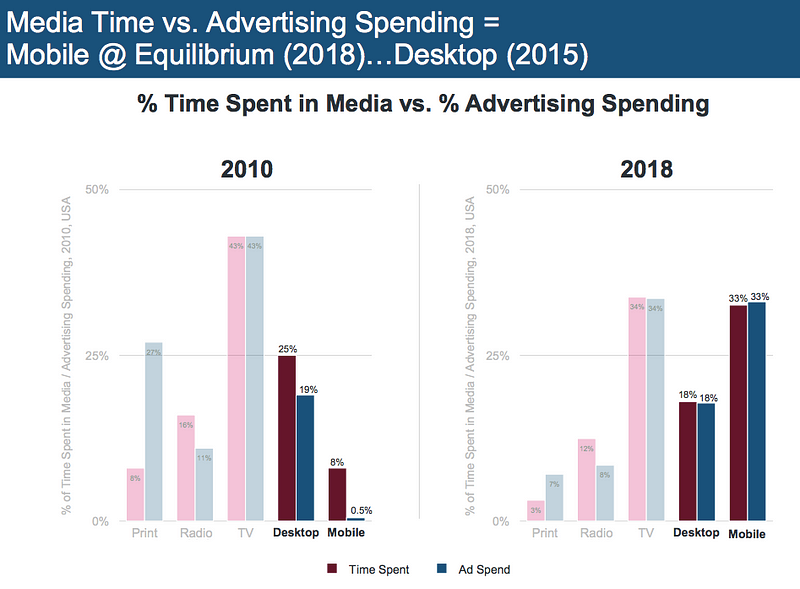
If we look at ad spend back in 2010, one salient point is that the share of Print ads is much larger than time spent on the medium 🗞 >⏳, meaning it was grossly overpriced. In comparison desktop, mobile and radio was underpriced 🖥, 📻, 📱 < ⏳ and TV was priced just about right 📺 =⏳.
Let’s compare this to the situation in 2018: which looks like this
- Print is sill overpriced 🗞 >⏳, yet to a lesser degree (in absolute and relative terms);
- 🖥, 📱, 📺 =⏳, mobile and desktop are now priced right;
- 📻 <⏳, radio is still underpriced. The chart doesn’t include the larger voice medium, in particular Podcasts, which we know since the 168-pages slide deck from a16z is severely underpriced attention (i’ll do a separate post on this one soon).
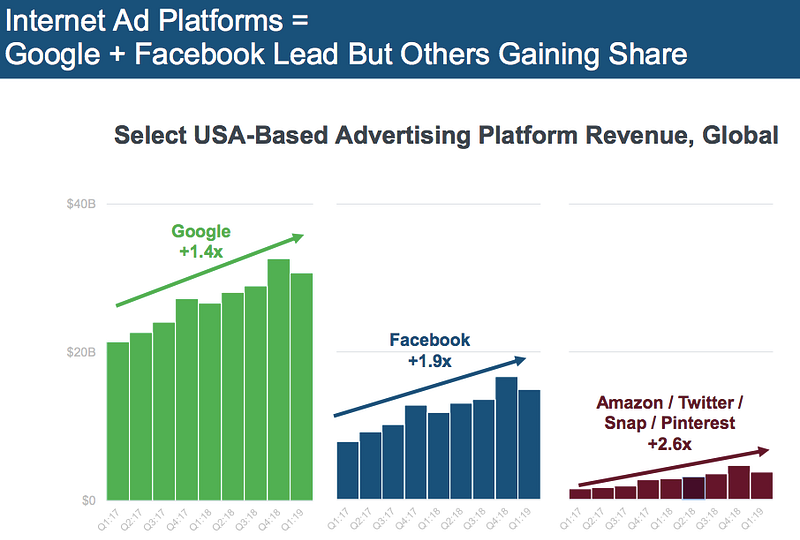
The dominant forces in the attention economy keep growing. The smaller social players are growing faster, but from a smaller basis. Amazon is also moving into online advertising. Ads have been a major growth engine for them recently, growing at almost 100% over the last few quarters.
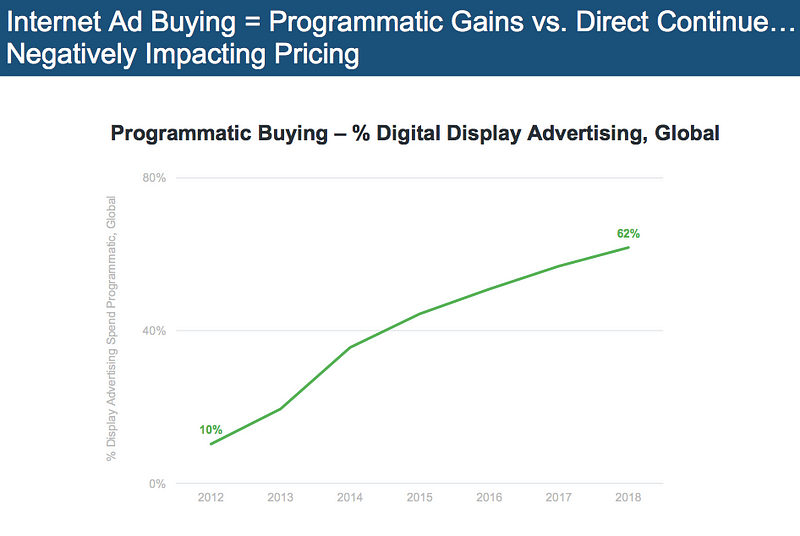
Programmatic buying, aka micro-targeted Google and FB ads, is now at almost 2/3 of total online ads. This means, unless you’re the NYT, forget calling advertisers directly ☎️ to sell your banner ads. It also means, as a consumer you’re now getting micro-targeted like never before. 📌😬
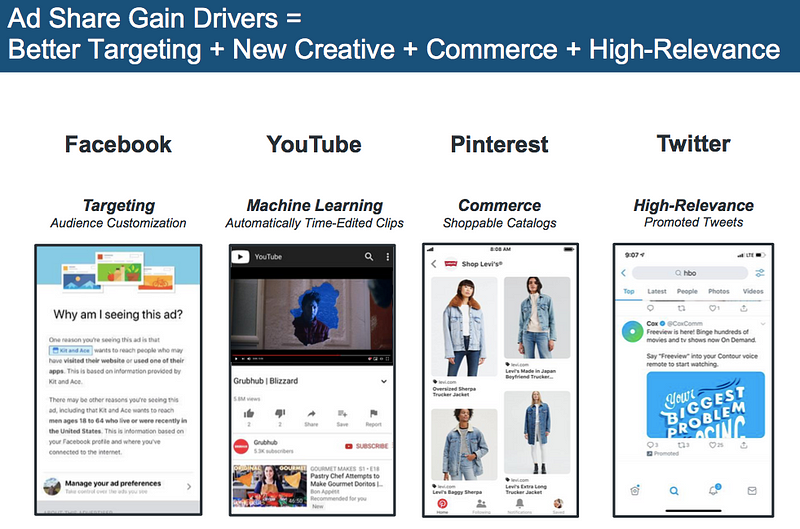
Targeting is also getting more creative and precise, as Meeker tries to demonstrate with the above examples from the ad product iterations of the attention economy incumbents. The irony of Pinterest’s example was not lost on me…as some of you might know, Pinterest was actually a pivot from the online catalogs app Tote, which was their first product. It seems that the circle is now closing 🔄 and that Pinterest is now back where it started but with the firehose of millions of DAUs. 😎
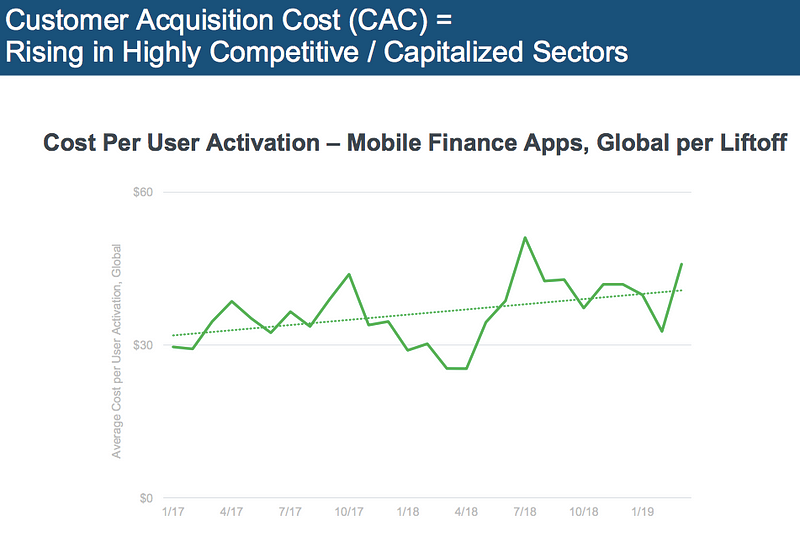
I’m glad that Mary brought up the rising CAC levels. I personally refer to this as the Google and FB tax of tech startups. Chamath Palihapitiya has been quite openly critical about this, saying that startups spend almost 40 cents (!) of every VC dollar on Google and Facebook ads. Many startups are pumping through their Series B dollars straight into FB and Google, get a high CAC, fake growth and then hope to be acquired by them: that’s clearly not a sustainable model!
I love how Meeker is quite frank about this in this years report, writing a reality check:
Reality =
CAC Can’t Exceed LTV for Very Long
That’s why I always say: raising money is not the goal, but finding a low CAC, high LTV model is. Build distribution into the product, or as Meeker puts it:
Effective + Efficient Marketing =
One’s Own Product +
Happy Customers + Recommendations
She backs it up with some of the best-known examples:
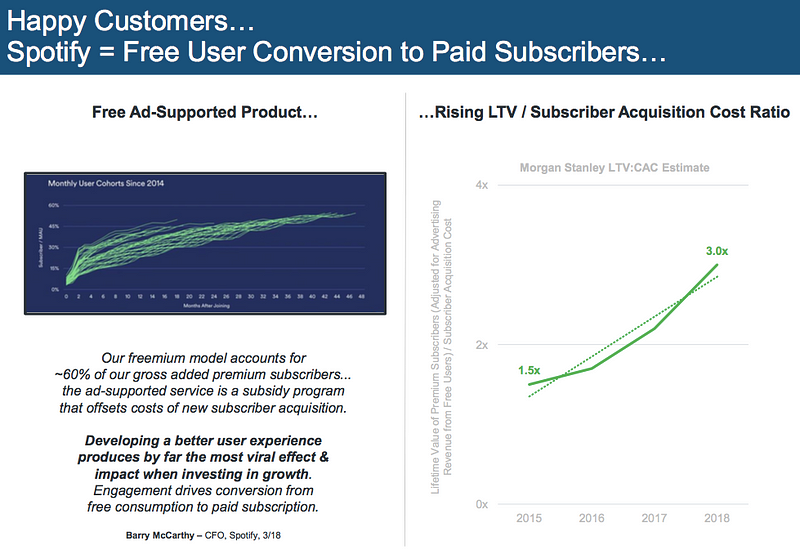
Look at this juicy 3x LTV:CAC ratio that Spotify is sporting there across cohorts.🤤
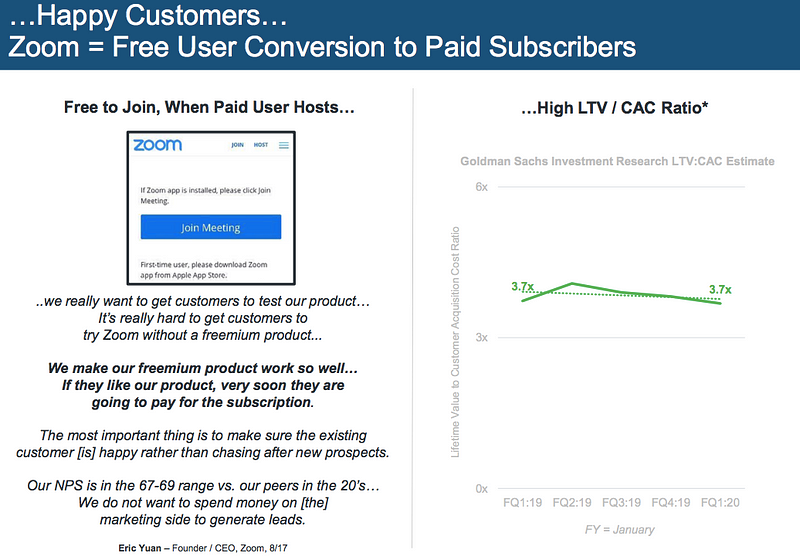
The Zoom story has been a highlight. I talked about the IPO pop before. Yesterday, Logan Bartlett from Battery Ventures reminded me again on Twitter that Zoom had a negative (!) churn of -40% in addition to a stunning 3.7 LTV:CAC ratio.
In other words, new costumers will pay 40% more by the end of the year, including the ones who have attrited. As Tomasz Tunguz from Redpoint pointed out when analyzing the Zoom S-1, this 140% Net Dollar Rentention puts Zoom in the top quartile of other benchmark companies. Eric Yuan always touts the high NPS score, because that’s essentially what’s making this a sustainable low CAC model. Build distribution into your product!
Internet Usage
This part of the presentation starts out by pointing to the macro trend of the increase in time spent online.
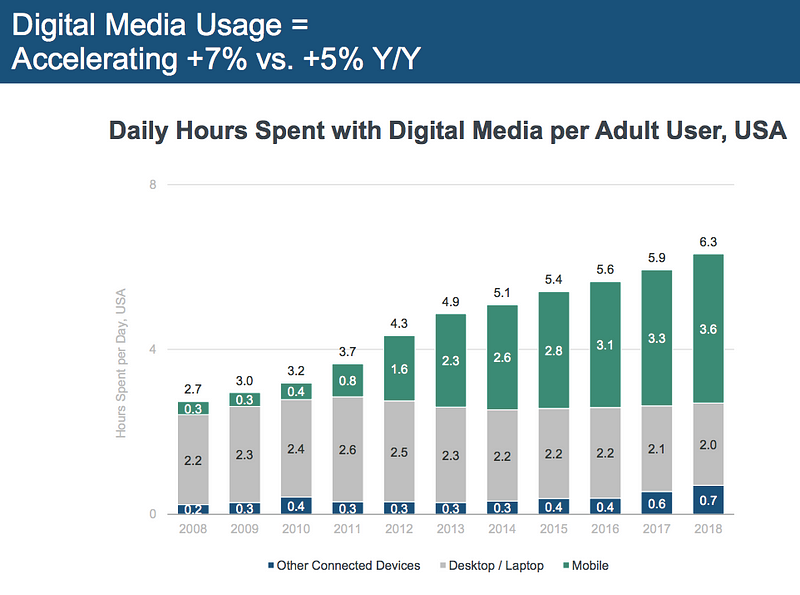
Desktop has been pushed out by mobile over the last few years. Overall it’s almost doubled to 6.3 hours that we spend on average in front of screens, letting our brains get totally rewired.🔌 😜 Obviously pretty unhealthy to be captured in the constant dopamine loop (more on that later). The sharp growth in mobile is also reflected in this graph:

Again, I have three smartphones in use 📱📱📱 and no telly 📺. Like most millennials I do OTT, aka Netflix and YT, so the time spent in passive consumption is still substantial. If we look at the chart above, the decrease in TV wasn’t massive, mostly we’ve seen a rise in mobile, rather than a replacement of TV.
The report then drills down more into where exactly we are spending our time online.

This is basically the rise of over-the-top (OTT) media services, the Netflix, Hulu’s, HBOs and Amazon Prime’s of this world over the last decade, but also the advent of YT user-generated content of course.
A parallel development is the recent rise of short-form video. The slide below shows the rise of short-form video within the ‘Facebook family’, but Snap and TikTok is obviously part of the same trend. It’s the ‘too long; didn’t watch’ (tl;dw) development, similar to the tl;dr in the bloggosphere.
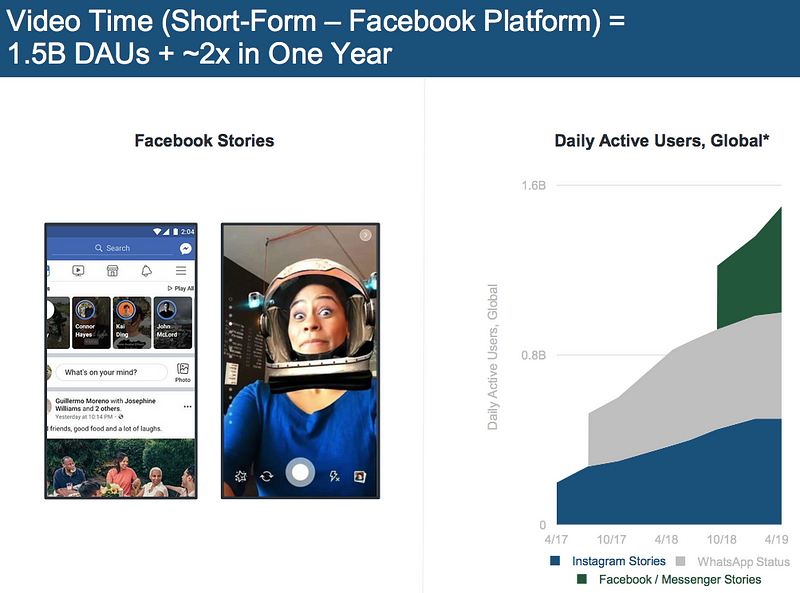
Another major growth segment in internet usage has been podcasts. Again the 168-page slide deck by a16z deserves its own post.

In podcasts we’re seeing in my opinion both (i) a power-law distribution, with the most popular podcasts clearing out most of the market and (ii) an underpricing of attention relative to other media.
The deck then goes through a number of case studies of Non-USA high-growth startups, in particular from Asia (Pinduoduo, Meituan Dianping, Tokopedia, Shopee, Reliance Jio, Alipay, Toss, Grab), Latam (Rappi, Nubank, MercadoLibre) and Europe (Revolut). They are all super interesting and sure deserve some more detailed analysis, but I personally don’t quite see how they fit into the greater theme of ‘internet usage’ within the report.
It becomes a bit more focused in the next subsection, where Meeker tries to highlight two macro trends in internet usage with respect to the way we communicate. In particular, she focuses on communication through (i) images and (ii) interactive gaming.
Internet usage: power of images in communication 🖼🥊
She starts out a bit historical, saying images are the oldest form of transportable communication.
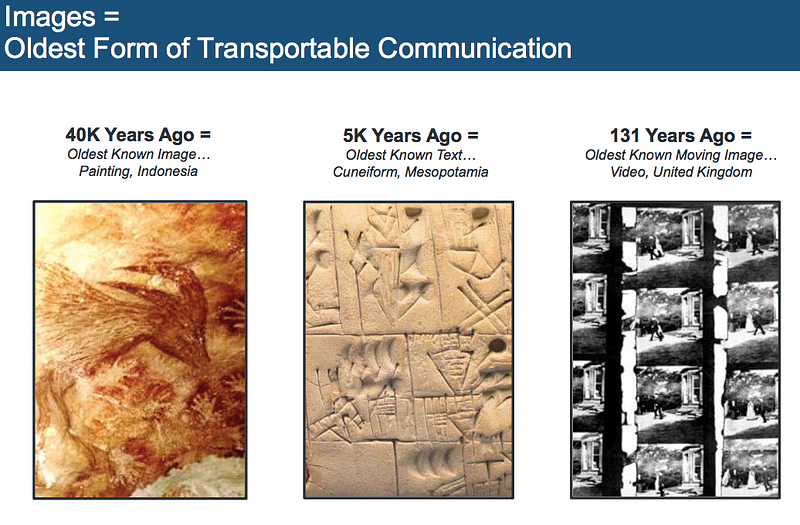
She then compares it with communication via text and numbers, which she describes as the dominant form in offline, one-to-one communication. The point being that words and numbers are in a way a heuristic — absent the ability to communicate through images. I think this point is best hit home by this Kevin Systrom (founder of insta) quote she later brings up:
People have always been visual — our brains are wired for images. Writing was a hack, a detour. Pictorial languages are how we all started to communicate — we are coming full circle.
So the way this plays out in her narrative is that the foundations for image creation have been ramped up massively in the past decade, setting the stage for massive image communication through the internet. 📸🔈 Smartphone cameras, cellular data, the whole shebang has hockey sticked north.

This has given us the infrastructure to communicate through…what kind of images exactly? 🤷🏼♂ ️
Selfies 🤳🏻, belfies 🤗 and helfies 💁🏼 you name it. The internet is obviously littered with those (not that there’s anything wrong with that).

And this where she gets concrete, going into the product iterations of some of the dominant social platforms: twitter, insta and pinterest.

Image tweets get a lot more impressions, nothing new to us. It’s the essence of the tl;dr culture: ‘don’t write a book 📚, say it in a blogpost 📑, say it in a tweet 💬, say it in a picture 📸, say it in emoji 😃.’
As our attention span decreases, pictures > words.
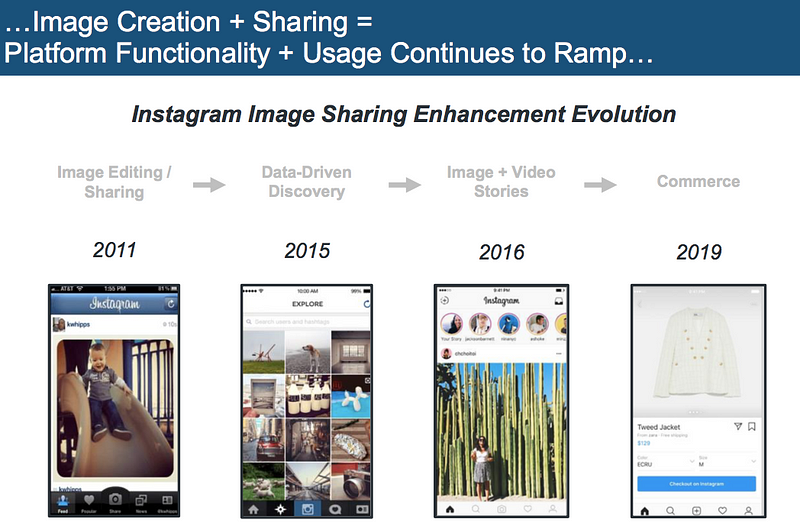
…and instagram has evolved essentially into an image-based e-commerce platform with the introduction of checkout earlier this year. My friend has been predicting this for years. Same goes for Pinterest, the ‘insta for soccer mums’ 👩👦👦⚽️ (or soccer dads, no gender-normative statements intended).

Internet usage: interactive gaming as communication 🕹
The next macro trend in internet usage/communication she identifies is the whole MMO (massively multiplayer online games) trend and how this links to communication. Obviously she kicks it off with a case study on Discord, the ‘Skype for MMOs’ if you like.

She then goes through the whole Twitch and Fortnite engagement metrics, which are obviously pointing only north ⬆️.
What I found most interesting about this is that she then starts focusing on ‘Squad caps’, meaning the maximum number of multiplayers allowed in the MMO sessions and communication groups. For example, the Fortine Voice chat is capped @ 16 squadmates, while Battle Royale and Events are capped @ at 100 players.
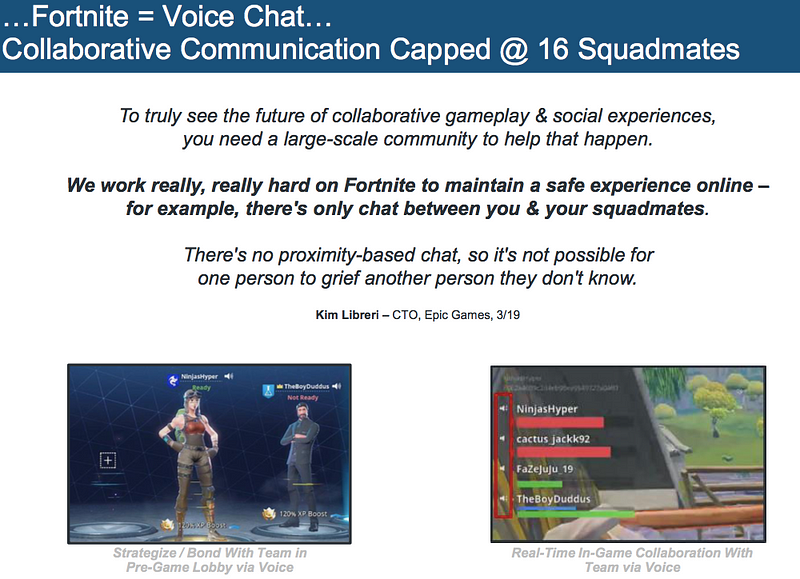
Not sure what this teaches us about internet communication in general, but I would say that it’s basically that effective communication cannot work at anything > (Dunbar’s number / 10). In other words, despite the internet being a huge place, communication still takes place in small tribes.
Freemium Business Model
The next thing she focuses on is the freemium model, which obviously has been around forever (essential since Fred Wilson’s 2006 blogpost) and can’t really be described as an ‘internet trend’ anymore at this stage. She goes through examples from gaming, enterprise and consumer and shows conversion rates over time.
Starting with gaming:
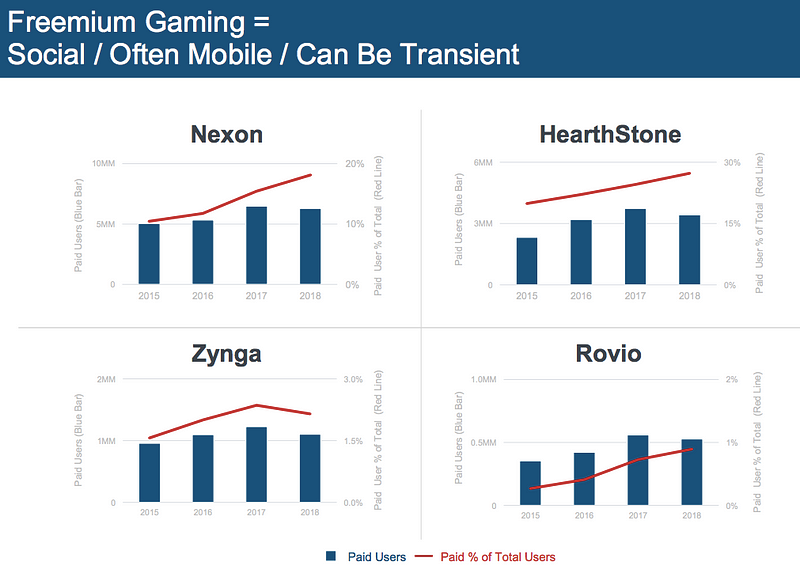
The “can be transient” is probably with respect to Zynga, which hit a bit of a bump in the road in 2018, but has seen increasing conversion rates more recently.
Similarly on the enterprise side, it seems like subscriptions track overall usage and engagement rates of freemium users. So what’s the internet trend here? Freemium still works i guess.
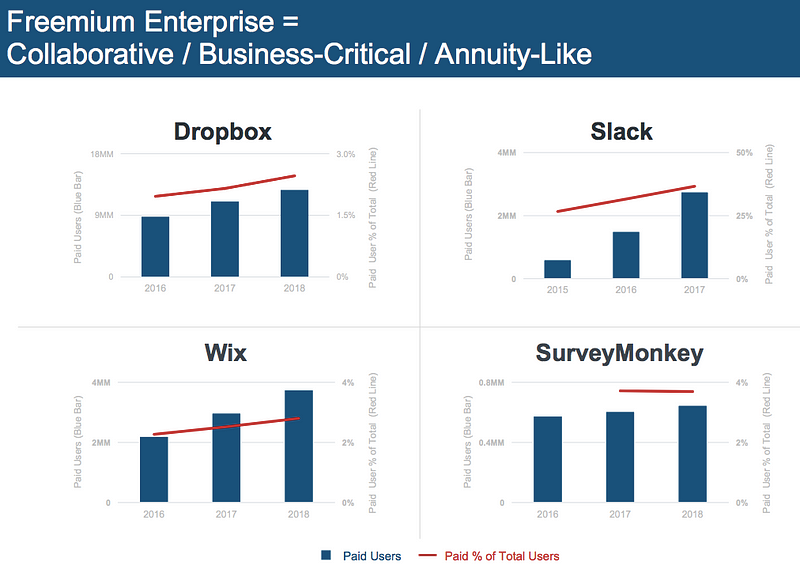
The last example she brings from consumer is Canva.
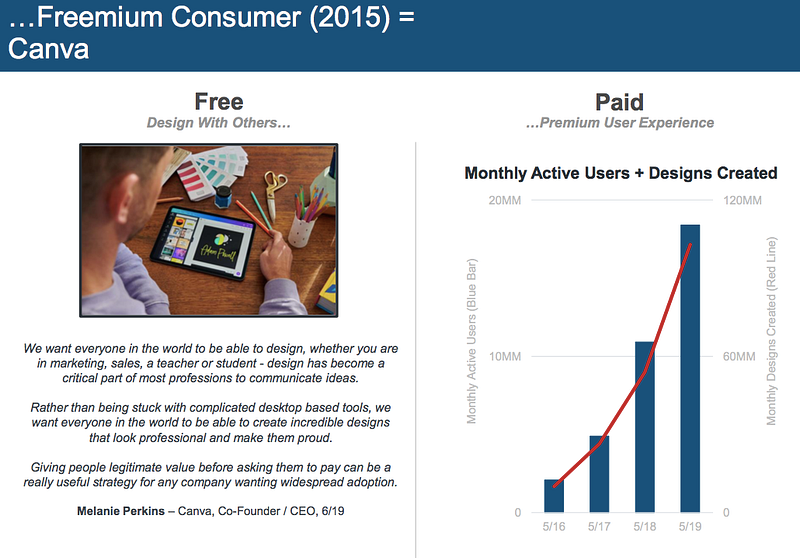
Canva is actually one of the first Mary Meeker deals in the new Bond Capital fund structure. Bond led the $70m Series D along with General Catalyst.
Either way, the overall story here seems to be that the freemium model is thriving in both B2B and B2C. In other words, if you want people to use your product, let them use it!
She then links this success of the freemium model to two somewhat related developments, which she calls the ‘freemium business model enablers’: in particular, this is the increase in cloud deployment + efficient digital payments (which is required for the upgrade to premium subscriptions).
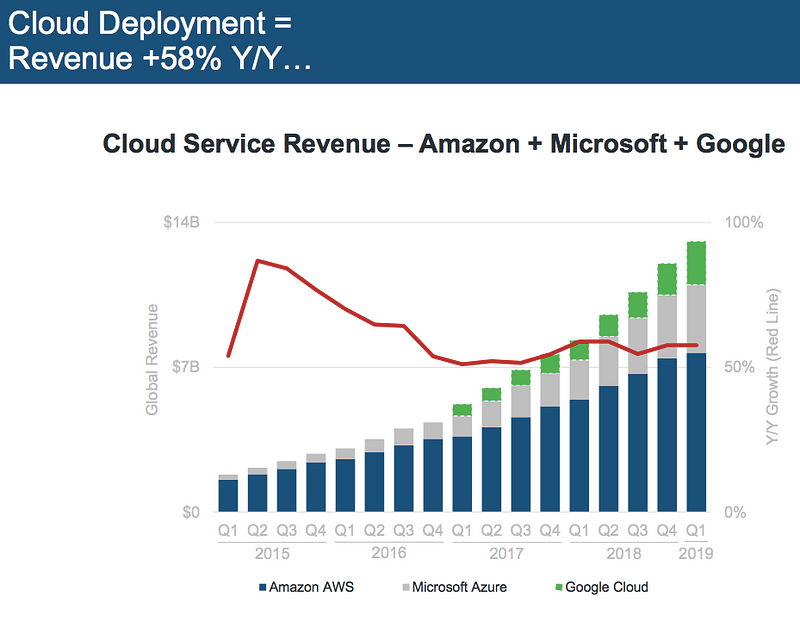
AWS is a cash cow 🐄, we all know this. I’m missing my favorite cloud provider though, where’s my Digital Ocean droplet in the chart above?
Data Growth 📊
The next topic covered is data growth or rather data explosion 💣💥. At first sight this looks a bit like the whole ‘big data’ narrative we’ve been hearing for quite a while now, with the ‘big data’ buzzword’s cousins ‘Artificial Intelligence’ naturally also making a quick appearance.
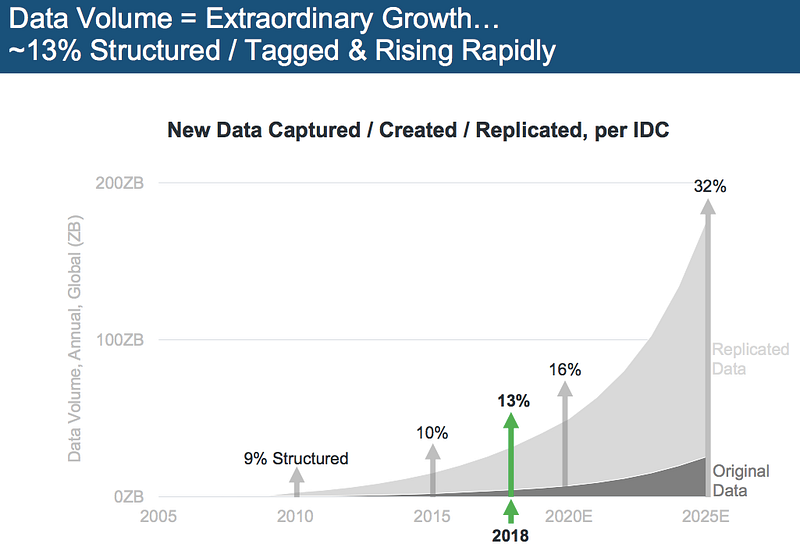
However, the narrative is actually a bit more specific, as she’s basically telling a then-and-now story of YC “talk to customers” mantra (but for big corporates).
She starts out talking about pre-1995 winning businesses, which wereusing human data and insights to improve customer experiences…

She gives similar case examples of Nike, Chrysler and Intuit and then contrasts this with the post-1995 winning businesses, which now use digital (instead of human) data and insights instead to improve customer experiences. She calls these firms the ‘data plumbing tools’. 🛠
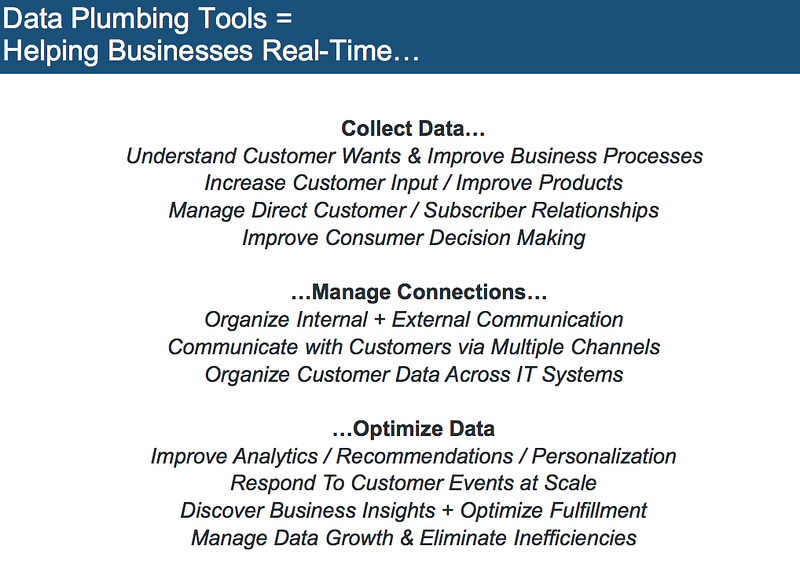
The deck then goes on to provide an extensive list of case studies, which are meant to showcase the rise of these data plumbing tools.
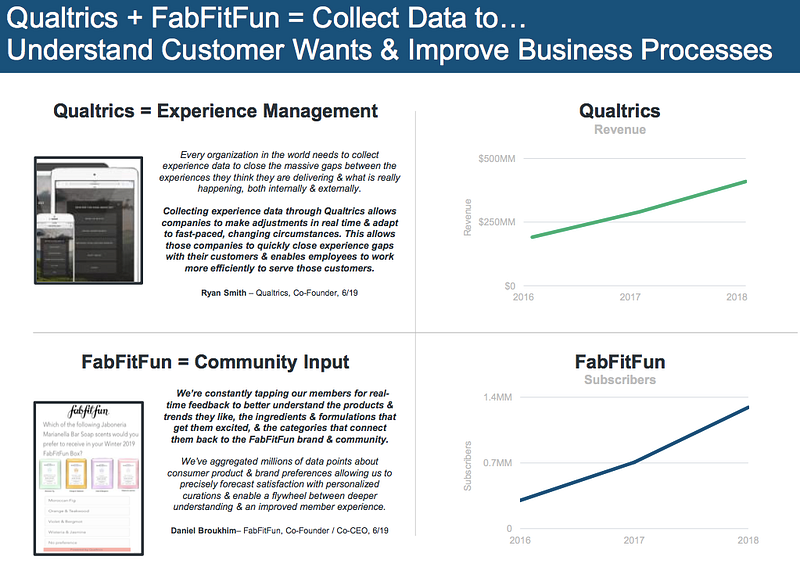
Qualtrics is obviously a very nice example. I just listened to the Ryan Smith session with Jason Calacanis a few days ago. Impressive story for any lover of bootstrapped businesses and the ‘grow slow, grow real’ mantra.
The deck includes a bunch of similar examples, where data plumbing companies help other companies become more customer-centric: Saleforce + Adidas, Plaid + Betterment, Slack + Hellofresh, Twilio + Shopify, Segment + Meredith, Snowflake + Instacart, Confluent + Accord, Looker + FarFetch, UiPath + Sumitomo. Mostly intra-startup deals it seems, worth checking out if you’re not familiar with some of these late stage companies.
The whole narrative she’s trying to make is probably best summarized by this quote from the CEO of Looker:
Data is the new application.
Ironically Looked was just acquired by Google last week for $2.6bn.
Usage concerns: the darker side of the internet 🌚
Fortunately, Meeker’s report is not all happy clappy. 👏🏻 She also points to some very valid concerns about the internet…starting with a British teens study about the downside of social media:
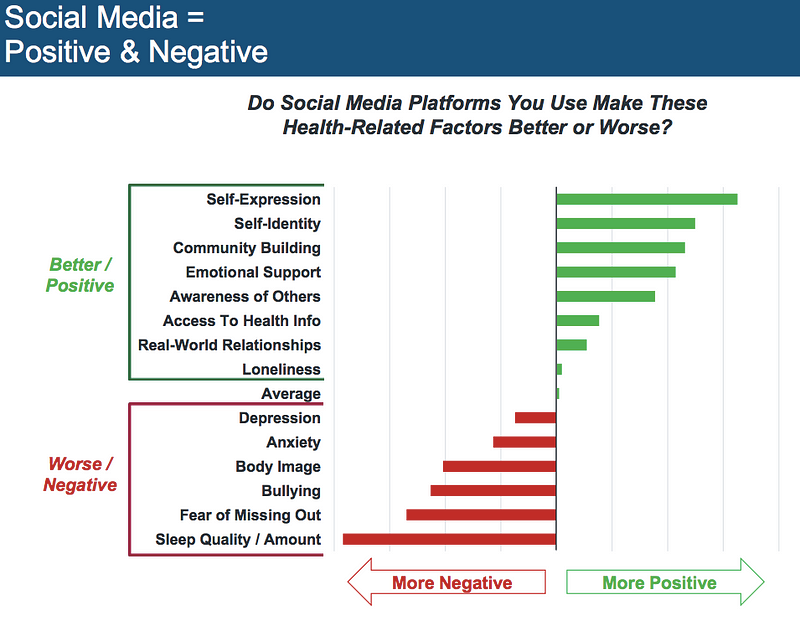
Unlike in previous ages, all major threats to humanity 🚨 now come from abundance rather than scarcity: whether it’s obesity coming from an abundance of food or mental health coming from too much screen time. Digital fasts are now increasingly on people’s agenda and the data shows this.
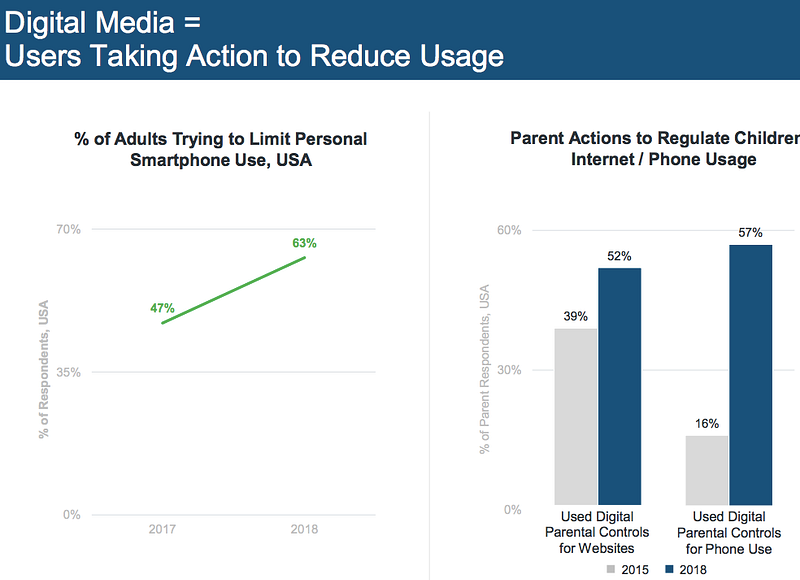
The gatekeepers of the attention economy have also taken notice of this trend in their latest product iterations and have (some say preemptively) introduced features that help us curtail our usage:
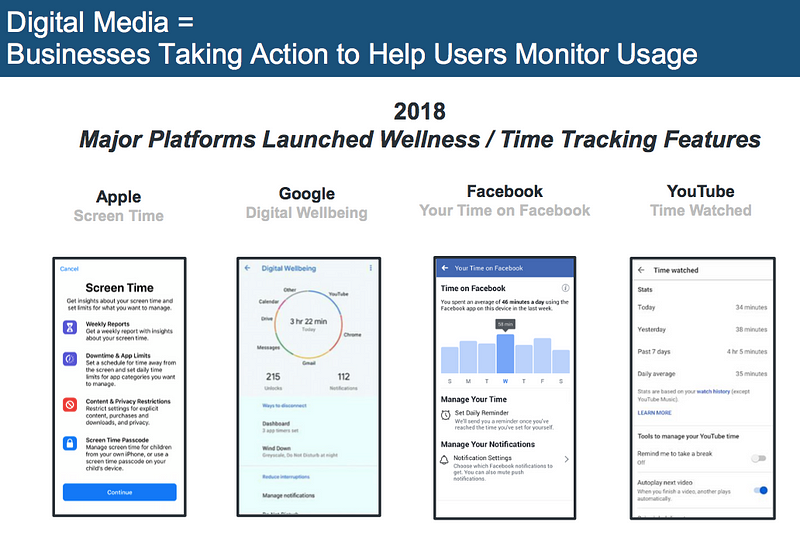
Digging a bit deeper into the dark side of the internet, she also points out the increasing polarization that the internet brings about.
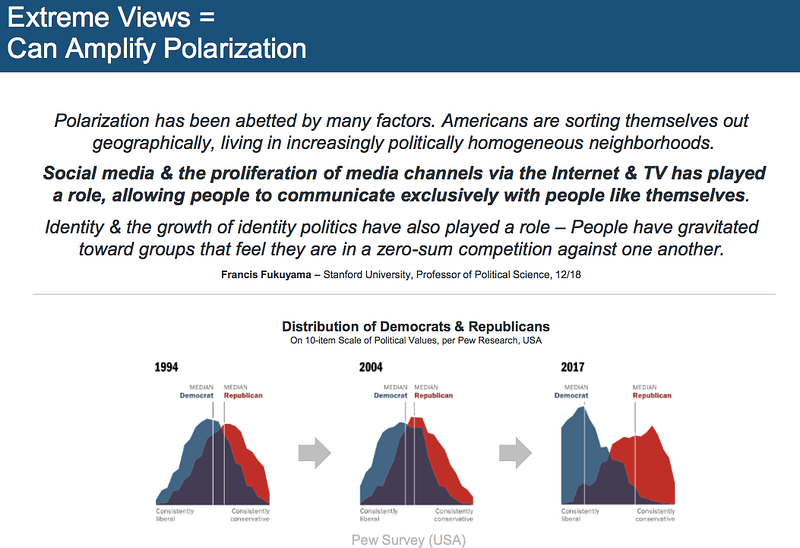
In a way it’s a bit like Naval Ravikant recently said on Joe Rogan:
we are trading the variance for the mean
The internet is a great place, you can easily find a couple of million people also programming in lisp or R, but you can also find millions of flat earthers and lizard conspiracy cult followers, who believe the world is governed by sentient, devil-worshipping, shape-shifting reptiles 🦎.
This is why fact checking services and ground truth sources will become more and more important imho.

Work 💪
Moving on to more positive territory once again, the report looks at the impact of internet on work. One field where the internet obviously had some major impact on work has been in the on-demand segment, also known as the ‘sharing economy’ or ‘gig economy’.
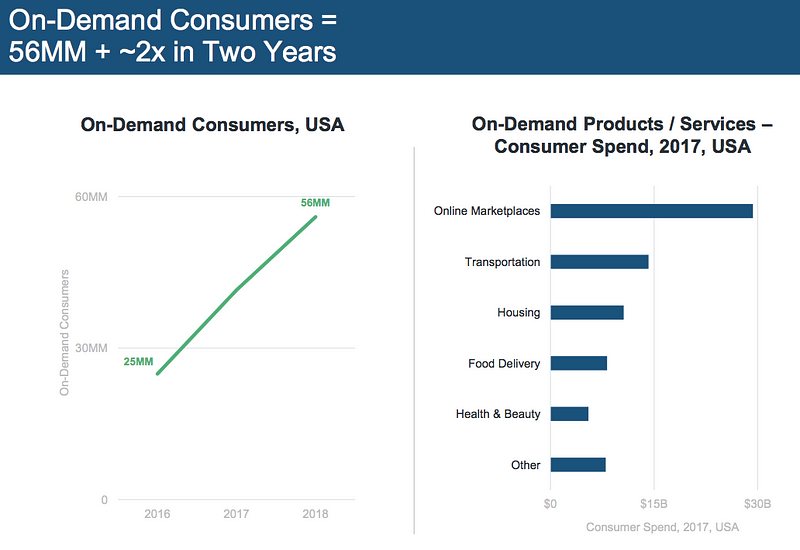
On demand workers have been on the rise for the last few years, coming in at $6.6m in 2018 in the US, almost triple what they were 3 years earlier.

From what it seems, the on-demand work model is primarily replacing unemployment or underemployment, rather than replacing long-term contracting. ‘Learning a new skill’ is also a major driver (let’s hope that’s not your next Uber driver learning a new skill 🤦♂️).

And here are the juicy hockey stick charts for the gig economy. Nothing new, but just heart-warming ❤️ to any VC who has still some carry locked up in these deals.

Education 🤓
The last topic I want to highlight from the Meeker report, is the impact of the internet on education. Yep, you’ve guessed right, it’s obviously the whole massive open online courses (MOOC) story + the individual share agreements (ISA) story, aka Lamda school, which has been trending heavily.
The deck starts out with the ‘traditional education is getting more expensive’ story, tuition ⬆️, student loans ⬆️, you know where that’s going…

… given the high costs of physical education: in comes the internet with massive one-to-many teaching models where people can learn about…what exactly? Bitcoin, machine learning and ‘como hacer una thesis’ it seems:
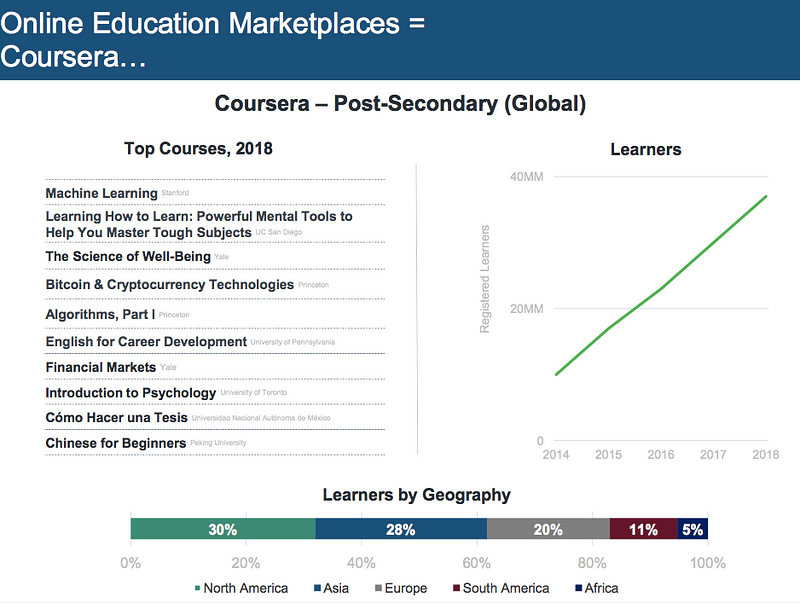
Then there’s obviously the Lamda school slide, which has been one of the hottest 🔥 and most hyped startups on VC-twitter in the last few months. Some critics, which have been cited in the NYT article that kicked off the whole hype have described this as Silicon Valley re-inventing indentured servitude. But as we all know “the boos always come from the cheap seats”.
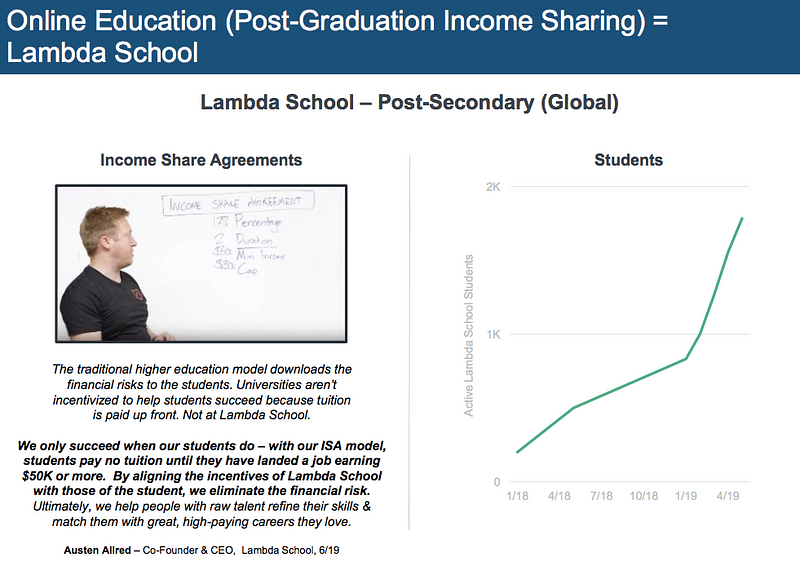
Then there’s a bunch of other hockey stick case studies, incl. Chegg, Quizlet, Remind, VIPKit, Byju’s, which are also worth checking out to get a flavor of the different models in the ed-tech space.
Obviously, the other side of online education is that it still has less signaling value (which the deck doesn’t mention) and that retention rates still ‘vary’, as she puts it. The retention bit I don’t find worrying, the signaling bit I personally find more troubling.
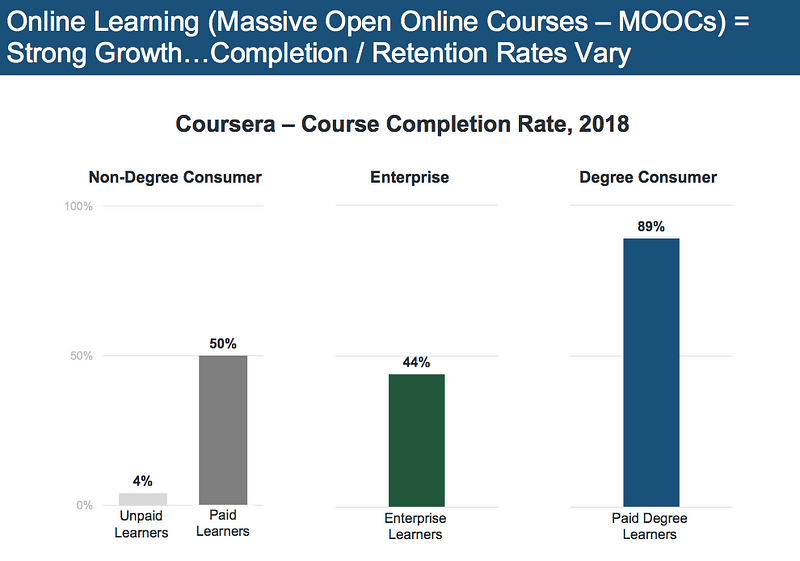
As an occasional academic Youtuber myself, I obviously liked this last slide on Youtube and also picked up a new term “Booktuber”, which is something I actually wanted to do for awhile. Sort of as a commitment device to clear out my list of unread books (but so far it’s only been ‘shelfies’).

Conclusion
Well, what can I say. Once again, the queen of the internet 👸 did not disappoint. The internet is still growing, injecting our skulls with ever more images 🖼, games 🕹 and data points 📊. We like it, but also we don’t like it that much, which is why we need to go on digital diets. So in the sake of limiting my own screen time, I’ll leave it at that.
Ttyl,
Erasmus
Sidenote: I also do voice recordings of these posts and smaller snippets in my newsletter, check it out if you want to get looped in.
